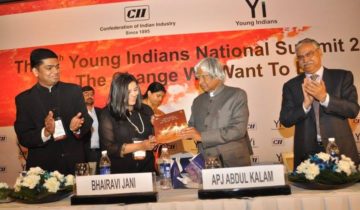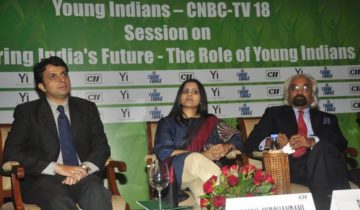Vyapam Scam. What is this scam about? At the law and order level, yes it is a scam and an illegal activity and a deadly one, literally. But I see different undercurrents. Having worked in conflict areas for past decade I can say this much about a wide spread scam or illegal activity: That there are members of the society itself that are the architect and the participants and those seeking to benefit from it are citizens deprived of their aspirations and who are impatient for actualization of their aspirations.
VYAPAM like many other scams or conflict economy issues is nothing but the powerful exploiting the system they control to create an economic cycle based on the following parameters:
1. Widespread unmet economic aspirations
2. Mismatch between skills, ability, qualification, propensity to earn and demands and needs of economic well-being
3. Sustained denial of developmental social and economic benefits resulting in exasperation, desperation and impatience
4. Architects and drivers of the system having first denied and delayed socio-economic welfare and creating an artificial environment of supply scarcity of jobs, skills, and livelihoods then become merchants who put a price on these very aspects, creating a market of buy and sell.
5. Lack of audit that gives alarms if there is an artificial or inorganic spike in supply side – for example the hideously highly increase in engineering colleges in Indore city alone in the past 5 to 7 years.
How do we miss all this? I am sure we can spot a thousand VYAPAM scams in many shapes and sizes if we look for the above parameters. Scam after Scam and there will be no end to it.
Therefore we need to find solutions and counters to the parameters and deflect the demand of such corruption. Corruption in most cases in civic bodies is about lack or controlled or constrained supply mismatched with overwhelming demand.
Madhya Pradesh had decades of negative growth and lack of strategic thinking in utilizing the natural strengths of the state and preparing its population for sustainable livelihood. This led to widespread unmet economic aspirations.
I have met students during my career counseling visits to Mandsaur and Neemuch five years ago (in the pictures) who would squat on a govt school bench and talk about being mechanical engineers, but if you asked them where they will work after they get a degree, they had no idea. Thousands of such students I met across Madhya Pradesh who were lost and yet had aspirations of livelihood and earning for which their education system was not preparing them at all!! The glaring difference between what they wanted to earn and what they wanted to provide to their families and their own abilities and skills was so huge, I recollect telling a few students at the ITI in Ratlam, “don’t go by what you see in movies, be realistic” and their response was a simple, “Didi if they can have it, why cant we?”
During my visits in villages in the state I had come across many a times, village Panchayat leaders complaining that despite collecting village land for a secondary school building the district education officer was refusing a permission to them. I have letters written by them in Hindi pleading and complaining to the Education Officer to give them the permission to build that secondary school. School for girls in many district headquarters had no separate class rooms for 8th, 9th and 10th standard students despite the school having the money to build extra classrooms the DM had refused further construction. The very confusing and vague Right to education act which demands certain amenities in a school made many schools close in small villages, and put many children at risk. The measures of keeping track of enrollment but not tracking the drop outs resulted in the ministry at the center taking credit for 100% enrollment, I recollect a tweet from Shashi Tharoor that once said, 104% enrollment, (how is that even possible??) but what about drop outs? Who was tracking those?
The lack of courses and faculty offered at many govt colleges across the state of Madhya Pradesh also resulted in many private education institutes coming up and with it the rise of VYAPAM was also ensured. Hence, an artificial supply constrain has been in place since many years in the state, and that too right at the beginning of the education system.
The fact that Indore city residents started boasting of 200 plus new engineering colleges coming up in Indore and surrounding area should have created alerts or given alarms. But no one reacted instead people were forecasting Infosys building its next big campus in Indore and TCS setting up a new facility and what not.
What we need to realize that this unmet aspiration and demand of a better life and better livelihood, the mismatch between the skills and ability and the expectation of livelihood, the supply side constraints so diligently created using government rules and vague policy by those in control and power, the same people creating personal economic wealth creation system out of this mismatch of supply and demand and lack of on ground measures is a deadly combination for many scams, as or more deadlier than VYAPAM scams.
And these scams are spread across the spectrum from health, to education to water to housing to food and across the length and breath of the nation. How long? How long will we allow this to continue? At some point systemic changes must kick in and reactionary actions of the government, the judiciary, the lawmakers and the fourth estate must diminish and people must realize that the collective ecosystem of conflict economics are created, curated both by people themselves and their representatives.
More than any border conflict it is this mismatch of unmet expectations and supply of opportunities that have and are creating vicious cycles of conflict that threaten to tear the very fabric of the nation.
Time to wake up and ask the right questions? I would like to start with my friends from Madhya Pradesh not because VYAPAM belongs to the state and its scam too but because Madhya Pradesh is “Hindustan Ka Dil” and if our heart is in peril, how can we rest? How can we remain silent?



